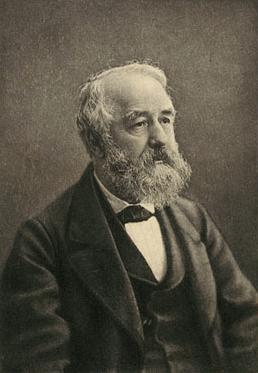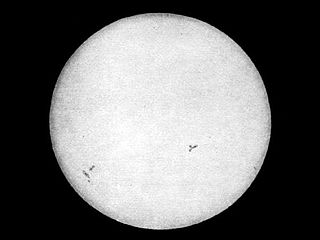
Sunspots are temporary spots on the Sun's surface that are darker than the surrounding area. They are regions of reduced surface temperature caused by concentrations of magnetic flux that inhibit convection. Sunspots appear within active regions, usually in pairs of opposite magnetic polarity. Their number varies according to the approximately 11-year solar cycle.

The Maunder Minimum, also known as the "prolonged sunspot minimum", was a period around 1645 to 1715 during which sunspots became exceedingly rare. During the 28-year period 1672–1699 within the minimum, observations revealed fewer than 50 sunspots. This contrasts with the typical 40,000–50,000 sunspots seen in modern times over a similar timespan.

Solar maximum is the regular period of greatest solar activity during the Sun's 11-year solar cycle. During solar maximum, large numbers of sunspots appear, and the solar irradiance output grows by about 0.07%. On average, the solar cycle takes about 11 years to go from one solar maximum to the next, with duration observed varying from 9 to 14 years.

The solar cycle, also known as the solar magnetic activity cycle, sunspot cycle, or Schwabe cycle, is a nearly periodic 11-year change in the Sun's activity measured in terms of variations in the number of observed sunspots on the Sun's surface. Over the period of a solar cycle, levels of solar radiation and ejection of solar material, the number and size of sunspots, solar flares, and coronal loops all exhibit a synchronized fluctuation from a period of minimum activity to a period of a maximum activity back to a period of minimum activity.

Solar minimum is the regular period of least solar activity in the Sun's 11-year solar cycle. During solar minimum, sunspot and solar flare activity diminishes, and often does not occur for days at a time. On average, the solar cycle takes about 11 years to go from one solar minimum to the next, with duration observed varying from 9 to 14 years. The date of the minimum is described by a smoothed average over 12 months of sunspot activity, so identifying the date of the solar minimum usually can only happen 6 months after the minimum takes place.

The Wolf number is a quantity that measures the number of sunspots and groups of sunspots present on the surface of the Sun. Historically, it was only possible to detect sunspots on the far side of the Sun indirectly using helioseismology. Since 2006, NASA's STEREO spacecrafts allow their direct observation.
The Spörer Minimum is a hypothesized 90-year span of low solar activity, from about 1460 until 1550, which was identified and named by John A. Eddy in a landmark 1976 paper published in Science titled "The Maunder Minimum". It occurred before sunspots had been directly observed and was discovered instead by analysis of the proportion of carbon-14 in tree rings, which is strongly correlated with solar activity. It is named for the German astronomer Gustav Spörer.

The Gnevyshev–Ohl rule is an empirical rule according to which the sum of Wolf's sunspot numbers in odd cycles with preceding even cycles (E+O) are highly correlated and the correlation is lower if even cycles and preceding odd ones (O+E) are taken. Sometimes a simplified formulation of the rule is used, according to which the sums over odd cycles exceeds those of the preceding even cycles . The rule breaks down under certain conditions. In particular, it inverts sign across the Dalton minimum, but can be restored with the "lost cycle" in the end of the 18th century. The nature of the GO rule is still unclear.

Sami Khan Solanki is director of the Max Planck Institute for Solar System Research (MPS), director of the Sun-Heliosphere Department of MPS, a scientific member of the Max Planck Society, and a Chair of the International Max Planck Research School on Physical Processes in the Solar System and Beyond at the Universities of Braunschweig and Göttingen.
Superflares are very strong explosions observed on stars with energies up to ten thousand times that of typical solar flares. The stars in this class satisfy conditions which should make them solar analogues, and would be expected to be stable over very long time scales. The original nine candidates were detected by a variety of methods. No systematic study was possible until the launch of the Kepler space telescope, which monitored a very large number of solar-type stars with very high accuracy for an extended period. This showed that a small proportion of stars had violent outbursts. In many cases there were multiple events on the same star. Younger stars were more likely to flare than old ones, but strong events were seen on stars as old as the Sun.

Solar cycle 1 was the first solar cycle during which extensive recording of solar sunspot activity took place. The solar cycle lasted 11.3 years, beginning in February 1755 and ending in June 1766. The maximum smoothed sunspot number observed during the solar cycle was 144.1, and the starting minimum was 14.0.
Solar cycle 4 was the fourth solar cycle since 1755, when extensive recording of solar sunspot activity began. The solar cycle lasted 13.6 years, beginning in September 1784 and ending in April 1798. The maximum smoothed sunspot number observed during the solar cycle was 235.3, and the starting minimum was 15.9.

Solar cycle 9 was the ninth solar cycle since 1755, when extensive recording of solar sunspot activity began. The solar cycle lasted 12.4 years, beginning in July 1843 and ending in December 1855. The maximum smoothed sunspot number observed during the solar cycle was 219.9, and the starting minimum was 17.6. During the solar cycle minimum transit from solar cycle 9 to solar cycle 10, there were a total of 655 days with no sunspots.
Solar cycle 18 was the eighteenth solar cycle since 1755, when extensive recording of solar sunspot activity began. The solar cycle lasted 10.2 years, beginning in February 1944 and ending in April 1954. The maximum smoothed sunspot number observed during the solar cycle was 218.7, and the starting minimum was 12.9. During the minimum transit from solar cycle 18 to 19, there were a total of 446 days with no sunspots.

The 774–775 carbon-14 spike is an observed increase of around 1.2% in the concentration of the radioactive carbon-14 isotope in tree rings dated to 774 or 775 CE, which is about 20 times higher than the normal year-to-year variation of radiocarbon in the atmosphere. It was discovered during a study of Japanese cedar tree-rings, with the year of occurrence determined through dendrochronology. A surge in beryllium-10 (10Be), detected in Antarctic ice cores, has also been associated with the 774–775 event. The 774–775 CE carbon-14 spike is one of several Miyake events and it produced the largest and most rapid rise in carbon-14 ever recorded.
Solar observation is the scientific endeavor of studying the Sun and its behavior and relation to the Earth and the remainder of the Solar System. Deliberate solar observation began thousands of years ago. That initial era of direct observation gave way to telescopes in the 1600s followed by satellites in the twentieth century.

Solar phenomena are natural phenomena which occur within the atmosphere of the Sun. They take many forms, including solar wind, radio wave flux, solar flares, coronal mass ejections, coronal heating and sunspots.

Patterns of solar irradiance and solar variation have been a main driver of climate change over the millions to billions of years of the geologic time scale.

Ilya G. Usoskin is a Finnish astrophysicist who is a professor at University of Oulu and head of Cosmic Ray Station at Sodankylä Geophysical Observatory. He is a Vice President of the International Astronomical Union since 2021.












